This panel discussion on digital inclusion and education took place in June of 2022 and was led by Myka Burley, Digital Inclusion Manager on the Rocket Community Fund’s Education and Employment team, with fellow panelists Margrit Allen, Executive Director of Urban Alliance, Detroit, and Elizabeth Lindsey, CEO of Urban Alliance who is based in Washington, D.C.
Urban Alliance is a national nonprofit organization that connects high school students to equitable, inclusive careers through paid work experiences, mentorship and professional development. Alongside other partners, the Rocket Community fund brought Urban Alliance to Detroit in 2018, and Rocket Companies serves as the largest employer of UA interns in Detroit. In this conversation, Myka, Margrit and Elizabeth discuss the relationship between the digital divide and systemic racism, and how we’re working together to support Detroit students and their families.
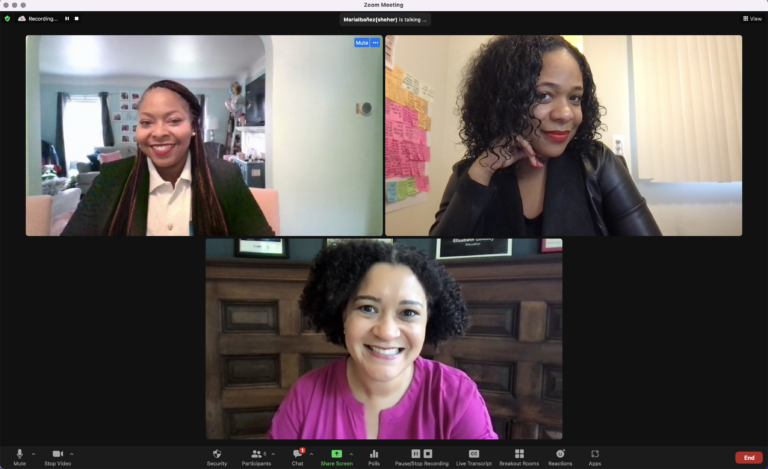
Myka Burley: Thank you both for joining me today! Margrit, can you explain what this program looks like for Detroit students?
Margrit Allen: We partner with the district to create a credit-bearing class where a senior spends a semester with us preparing for an internship, learning soft skills, and digital literacy. Students then qualify for an internship that lasts until the last semester of their senior year and the summer following. They’re placed with organizations like Rocket Companies, where they do real work.
Our goal is to ensure that every student that goes through our program has a viable next step. That could be to a four-year university, or a training which could lead to an industry-recognized credential, or entry-level employment with one of our employer partners… we want to ensure that all students have a viable next step when they go through our program.
Systemic Racism Creates Lack of Digital Access
Myka Burley: Thank you. And that takes us to the real meat and potatoes of our conversation. As we look at the cities that Urban Alliance is in, I would love to learn a little bit more from your perspective, Elizabeth, on the relationship between digital inclusion and systemic racism.
Elizabeth Lindsey: Absolutely. Digital inclusion is really a fancy way of saying, do folks have access to basic technology and the skills to use it and the broadband that they need so that they can live in the new economy? It’s a way of saying, are people equally and equitably connected to the world of technology and the world of being connected? There is no component of the economy that we can separate from 400 years of systemic racism in the United States.
So just like communities of color, and Black communities especially, have been systematically left out of economic engines, and stable housing, and access to education, we also have been left out of this digital wave, the digital transformation of our economy. So much of being digitally included is about being economically able to afford the technology, meaning internet and a device. So much of it is about access to education – learning how to use technology. Communities of color are left out of these systems. We’re left out of economic prosperity. We’re left out of equal education. And as a result, we are left out of the digital revolution that has changed the way we live our lives in ways that we can’t even count.
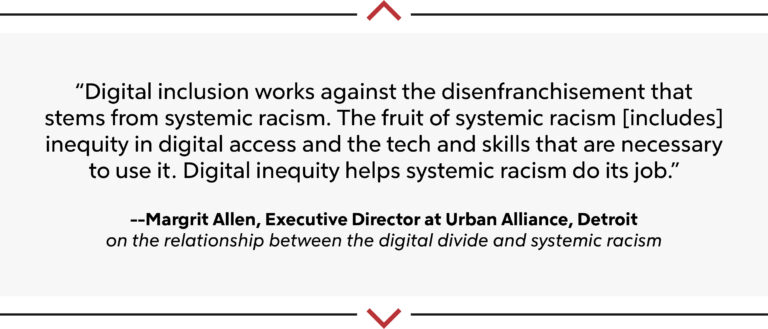
Myka Burley: Thank you so much for that. Margrit, as you work in the Detroit market, what correlation do you see between digital inclusion and systemic racism?
Margrit Allen: I would say that digital inclusion works against the disenfranchisement that stems from systemic racism. The fruit of systemic racism, things like income and wealth gaps and unequal access to quality, equitably funded public education, those things produce certain outcomes, and one of them is inequity in digital access and the tech and skills that are necessary to use it. Those are the things that perpetuate poverty, and they further disenfranchise people who are already disenfranchised.
Digital inequity helps systemic racism do its job. And I have a lot of examples of how this plays out practically. During the pandemic, things that seem intended to support families experiencing poverty, like applications for food stamps and scheduling doctor’s appointments – are done virtually. Much of the workforce development ecosystem has also shifted to virtual delivery. So it makes upskilling opportunities very difficult to access. Even applying for and working for an entry level job requires digital skills. I’ve seen a high number of students who have not performed well during the pandemic academically due to digital inclusion issues. But at the same time, they’re being asked to recover many of these missed credits virtually. So this lack of access, it’s a perpetuation of just the existing challenges that we face because systemic racism.
Digital Literacy Training to Bridge the Digital Divide
Myka Burley: That’s a really great point, Margrit. Given that so many of the training opportunities and literally the entire economy exists online and on computers, what would you say are the next steps?
Margrit Allen: As someone who’s participating with Connect 313, the pandemic forced us to own all of this, a lot has been accomplished, right? There are subsidies for households to support affordable internet in Detroit, there are partners – like Human-i-t – that offer low-cost tech.
And then there are community-led initiatives like Connect 313 that respond supportively to Detroiters asking for digital inclusion. But I would love to see a world where internet access is as basic as any other utility, where access to affordable tech is expanded. A world where digital literacy skilling is more widely available, at no cost to anyone who desires it.
Myka Burley: I love that perspective, Margrit, the way that you’re framing this, it feels as though you look at accessibility and literacy as an essential function. And I believe that it is. So when we think about that, from your perspective, Elizabeth, what do you say next steps are in the process of becoming more digitally included – outside of computers and high speed internet?
Elizabeth Lindsey: Yeah, I agree with everything Margrit said. We often take it for granted that everyone knows how to use technology. At some point we all learned how to send an email. At some point we all learned how to create a word document. And there are millions and millions of people in the United States, especially in communities that have been left out of our economic engines, who don’t have those skills.
There are adults, there are children, there are so many people who don’t have the digital literacy skills that they need in order to really be able to thrive online and to utilize technology to access services, to communicate with their families – even to apply for a basic job. So I really believe that we need to continue to emphasize the importance of that digital literacy skills training.
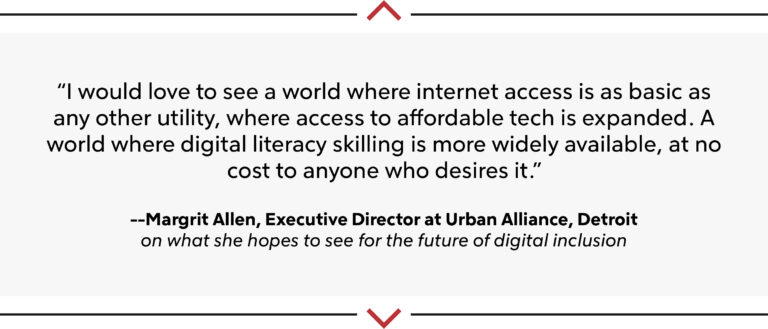
Myka Burley: Thank you for that. Margrit, do you have any additional thoughts?
Margrit Allen: I just think we really need to meet young people where they are with digital literacy training. It needs to be provided both virtually and in person. And a lot of young people enjoy the virtual engagement, and some do not. So I think we need to keep that in mind and acknowledge everything we’ve shared about the necessity of digital literacy and embedded in everything we do, youth development wise, at a very, very, very early age.
Digital Inclusion in Detroit and Beyond
Myka Burley: Thank you for that. So I think working closely with you, Margrit, and then also just being here in the Detroit market, I think we know quite a bit about how the digital divide has impacted youth in Detroit, but I’m really interested to learn more about any digital divide related nuances, data trends or insights that Urban Alliance has seen in its other markets. So, Elizabeth, can you speak a little bit to that?
Elizabeth Lindsey: What’s so insidious about the digital divide is that it kind of looks the same everywhere. What I mean by that is that it follows the same lines of segregation and disinvestment as housing instability and lack of access to great education. It goes back to exactly what Margrit was saying: this is a symptom and a driver of racial inequality.
In our other regions, it’s similar to Detroit. In Chicago, in communities on the south and west side, communities that are predominantly communities of color and lower income, nearly 40% of the neighborhoods there don’t have internet. One in three households in Baltimore city don’t have any access to a computer. And in DC, which is where I live, about a quarter of public school students didn’t have a device or Wi-Fi in 2020. So they were not able to access the type of education and online schooling that was required. In Detroit it’s the same, right? In neighborhoods where residents are most financially challenged, they have much less access to the internet.
Myka Burley: Thank you. How has Urban Alliance had to adjust its strategy to meet the needs of unique markets and combat these unjust systems ?
Elizabeth Lindsey: In 2021, for the first time, we rolled out digital literacy training for every single one of our high school interns. Every single one of our senior year students receive 20 hours of digital literacy training before they even begin their internship. We hear from employers across our markets, that our students absolutely have to be able to be fluent in using the Microsoft Office Suite, so they can utilize online calendars, email, and spreadsheets. These are the critical skills that they need to survive and to succeed in their high school internships and beyond, for the rest of their careers. COVID really laid bare for us that we are not preparing our students for the workforce or for continued education if we’re not providing them with really deep digital literacy skills training.
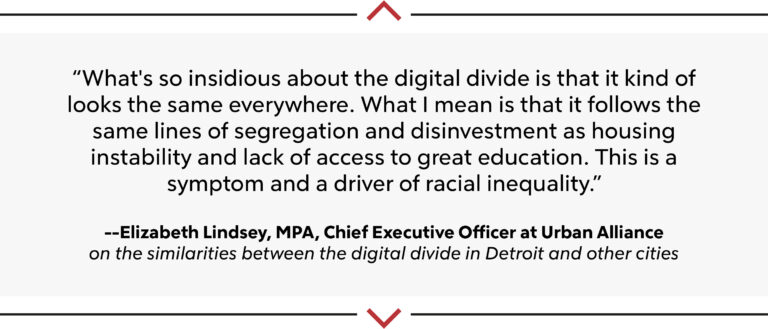
Myka Burley: Thank you for that. And Margrit, as you work in the Detroit market specifically, how have you had to adjust your strategy or your visioning with the work that you guys are doing with youth here in Detroit?
Margrit Allen: Similar to what Elizabeth shared, but we were also fortunate to have the support of the Connected Future’s fund for our students. We recognized that we can no longer take it for granted and assume that all Detroit families are digitally connected. At the outset of the program, we started to facilitate conversations about what used to be the Emergency Broadband Benefit. The name has since changed, but it’s a subsidy. So if you have a household that’s not connected, and you’re an Urban Alliance student, let’s get mom in here to get her connected. We even provided loaner devices to our students so that they would have computers for the duration of their training period. Rocket Companies has definitely been supportive and they provide access to their technology. But that was a new ask in our conversations with our employer partners to engage our students with their own technology. And lastly, we expanded our training. We increased the depth and the extent of the digital literacy that we provide.
“Zoom Fatigue” and Reimagining Digital Literacy
Myka Burley: Yeah, I love that. Knowing the climate of where things are now and with much of the workforce be operating in a hybrid environment, I know that many of the students in Urban Alliance had to complete their internships remotely both last year and even some this year. What changes or differences have you all noticed from the virtual experience as compared to the pre-COVID full in-person experience?
Margrit Allen: That’s a good question. Shout out to our employer partners! When the pandemic hit, we were so fortunate to have folks who were willing to pivot entirely virtually with us, and we didn’t know what that would look like. We were very fortunate, and so were our students. And this was during a time when isolation was common because we had all those quarantine mandates. UA was a lifesaver to a lot of students, and I would even say adult mentors. Engagement and attendance were both really high during a really critical time – the global health pandemic. Our student outcomes, during virtual delivery, were also very high: over 90 percent of our students went on to two- or four-year universities. And the others were involved in training programs and entry level employment after graduation. So really, UA was almost like a sanctuary for a lot of students – even with the “zoom fatigue.” We really just had no idea how positive it could be. Every day, they were practicing digital literacy skills out of necessity. So the virtual piece has definitely added value in a number of ways.
Myka Burley: Thank you. Margrit, you mentioned Zoom fatigue. And I think that we all have had our fair share of that. Aside from Zoom fatigue, have there been any challenges that you’ve noticed that have existed by engaging in a remote environment versus, or partially remote environment, versus fully in person?
Margrit Allen: For sure. In all fairness to our students, this current class of 2022, the last time they were in the classroom full time, they were starting high school. So they missed a lot of learn-by-experience opportunities to integrate socially, to be responsive to a supervisor, (aka, teacher), that’s not through a screen. So we’ve seen that our students need some expanded training. And we’re being responsive in that way. We’re really overhauling our curriculum to make sure that we’re meeting the needs of what some of our school district counselors call “pandemic kids.”
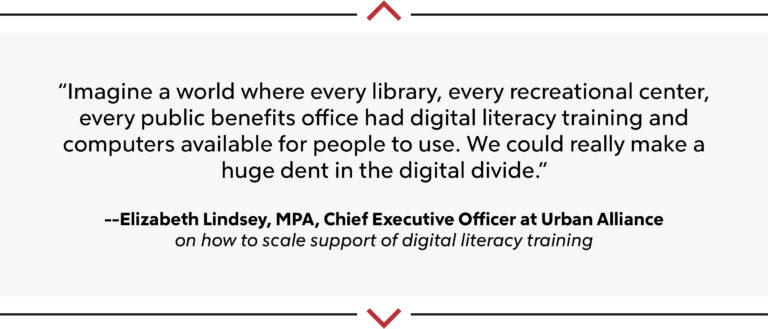
Myka Burley: I love that perspective. So Elizabeth, I’ll point this one to you, as we look at the opportunities that exist from operating in a virtual learning environment, how would you say this learning environment, virtual versus in person, what has the impact been on the digital divide, if any?
Elizabeth Lindsey: I think that this virtual environment, and now the hybrid environment, has really brought attention to the impact of the digital divide. I think before COVID, it was easy for us to be in our bubbles and just to be like, okay, well, everybody has internet. And if they don’t, it’s not a big deal. But it really became, in March, 2020 almost overnight, it became a matter of survival. It became a matter of, are you able to order your food so you don’t get sick or in the grocery store, are you able to even support your family by working? Are you able to, as Margrit pointed out, get the benefits that you need in order to feed your family? And so it’s definitely a shame that something like this had to happen before we really had this wake up call to see that digital equity is not a “nice to have.” Access to technology and the skills to use it are absolute necessities for people to live and have meaningful and comfortable lives in our society.
Dreaming of a Digitally Connected Future
Myka Burley: I agree with you completely. Margrit. I’d love to hear your perspective on the ongoing issue of digital inclusion – do you feel that this will be a more permanent conversation, or is this something that will be closed at some point?
Margrit Allen: Sure. Langston Hughes has a poem called “I dream a world.” So, I dream a world where the internet is a basic right. The same way we go to the sink and get water, and we turn on our lights. Of course we have to pay for it, but it’s regulated. There’s some exciting things happening in Detroit with regards to that, including an initiative that could potentially have municipal broadband for the entire city that’s affordable and isn’t based on whether there’s a federal subsidy that’s approved or dependent upon the benevolence of the provider. I’m just excited to see that launch and expand to other cities, so that you won’t be “dreaming of the world,” you’ll be living in it.
Myka Burley: I love that. There was a theme that showed up in both your last responses and words that I pulled out were hope and dream. And I think as we close out this conversation, it’s a really beautiful point to end thinking about what makes us hopeful and what we dream about. And I would love to hear, I’ll start with you, Margrit, what makes you most hopeful that bridging the digital divide is possible?
Margrit Allen: I think it’s conversations like these. People like you leading digital inclusion efforts with the support of Rocket Community Fund and the Rocket family of companies, and then the Office of Digital Inclusion in Detroit. Whoever heard of an office of digital inclusion before this? We are prioritizing digital inclusion, we understand it’s an issue. And I’m excited about the focus, the resources, and the energy that’s being put into it so much that an entire neighborhood is getting municipal internet in the city of Detroit very soon.
Elizabeth Lindsey: That was so beautifully said, I don’t really have anything to add. I’m excited that we, as a society and in our communities, are really recognizing how much the digital divide impacts our communities and we are working together to make a difference to close it even faster than we ever thought possible. So, it’s just really exciting.
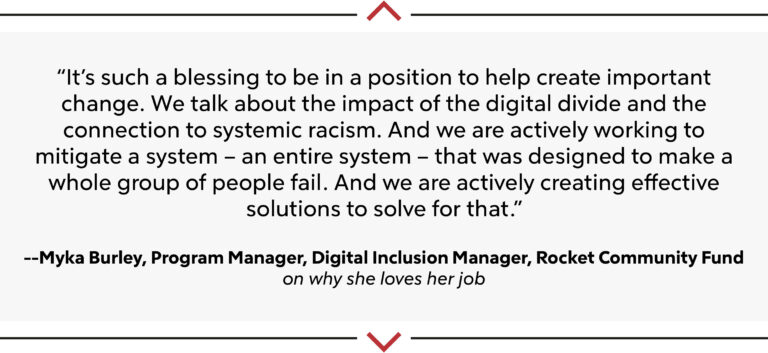
Myka Burley: I agree with you. And I think that on that front of that excitement, Margrit, you mentioned Rocket being part of helping to bridge the digital divide here in Detroit. And I think that just brings me to the concept of collaboration – the digital divide is something that we all can collectively agree is essential for us to bridge together. This collaboration has really helped to push forward the issue. I think that level of collaboration, and connection and desire as a community is really what makes me feel hopeful that the digital divide will be closed at one point very soon. It’s such a blessing to be in a position to help create important change. We talk about the impact of the digital divide and the connection to systemic racism. And it’s like, we are actively working to mitigate a system – an entire system – that was designed to make a whole group of people fail. And we are creating effective solutions to solve for that. What more could you hope for? Thank you both for joining me in this very important discussion today.